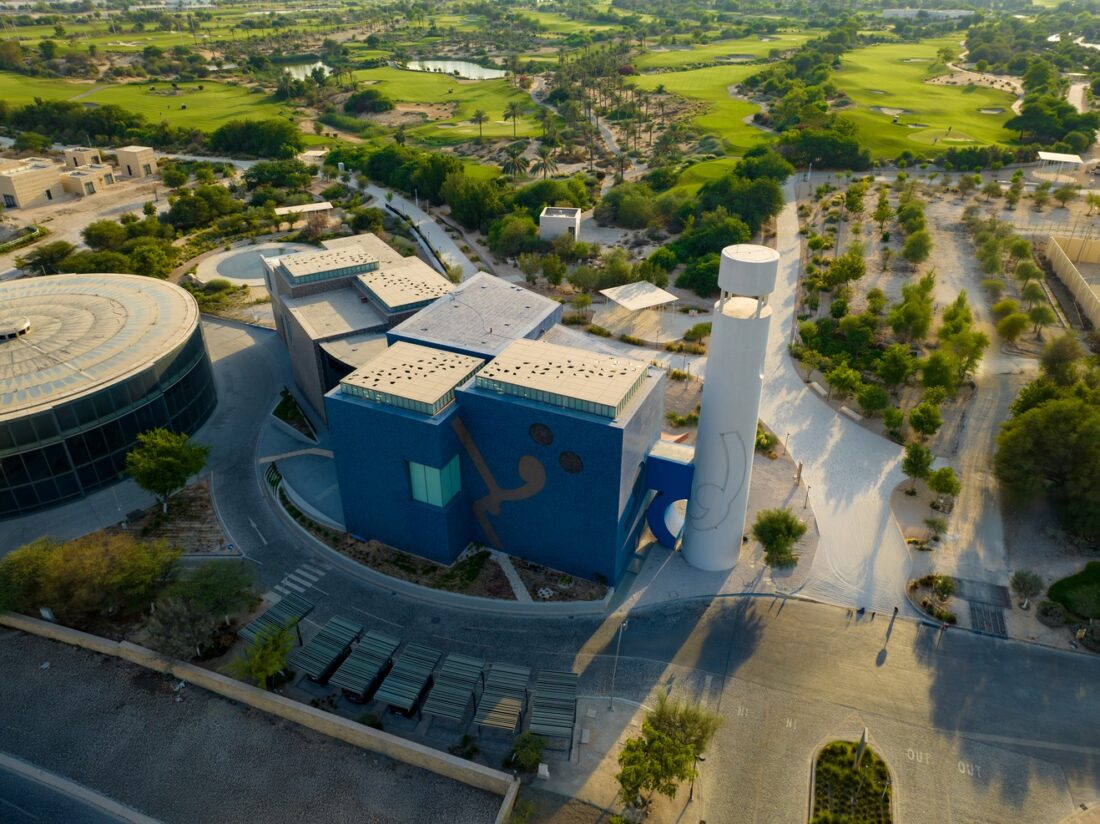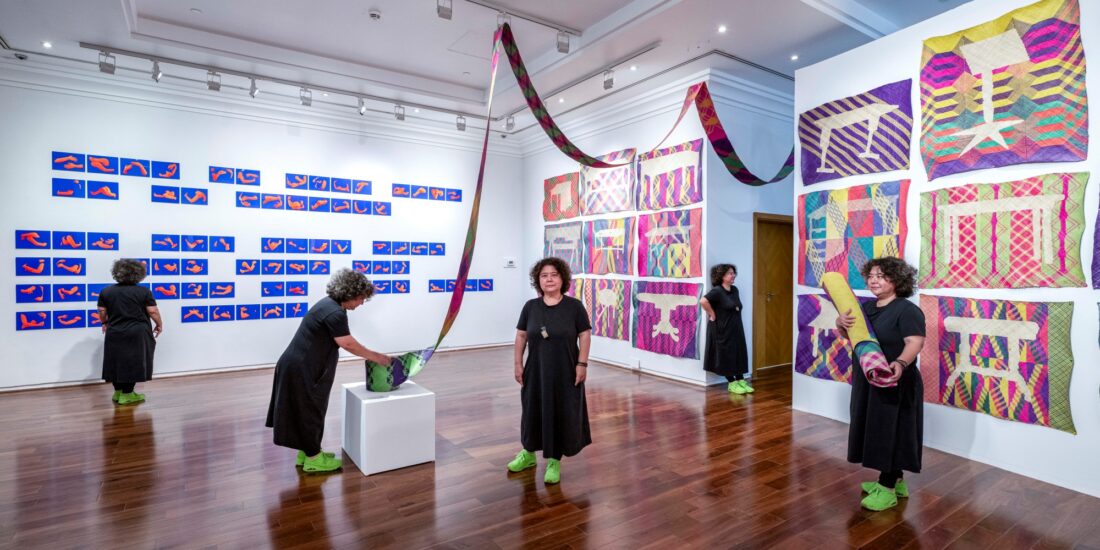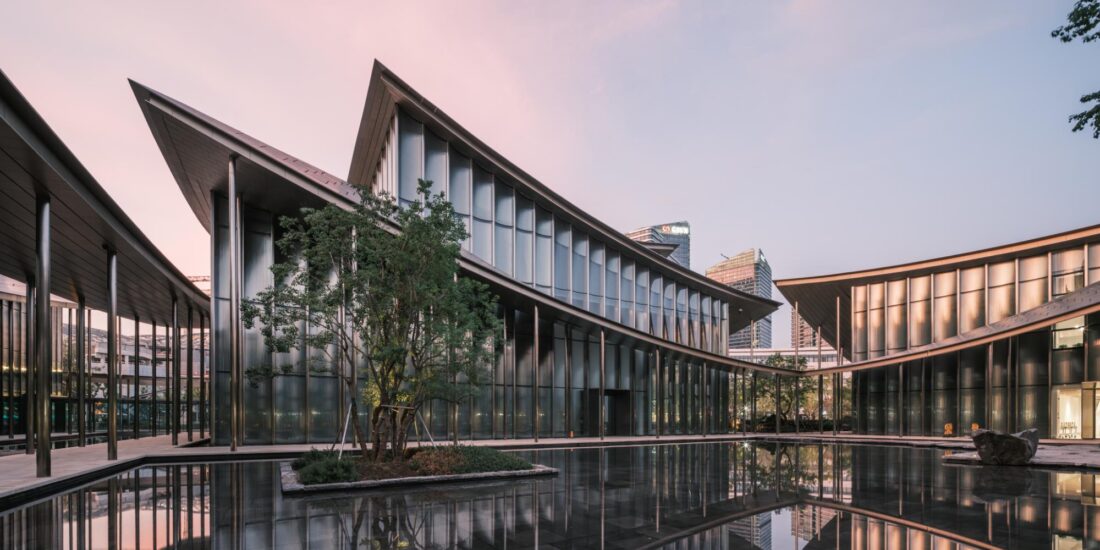Lawh Wa Qalam: Understanding the Museum Dedicated to M. F. Husain
A conversation with Noof Mohammed, Project Manager, Art Portfolio, QF Communications, to understand the vision behind Lawh Wa Qalam, a one-of-its-kind institution, a museum that honours one of the most prolific artists of the past century, M. F. Husain. A space that celebrates Husain’s cross-cultural synergies, his belief in art beyond borders and politics, and the dualities that shaped his extraordinary creative journey.
When Lawh Wa Qalam: M. F. Husain Museum opens its doors on November 27, 2025, at Education City, it becomes more than a tribute to one of the world’s most prolific modernists, it becomes a translation of Husain’s imagination into architecture, storytelling, and art. Rooted in a sketch the artist left behind in Qatar, the museum carries forward his spirit of curiosity and cross-cultural dialogue. But most importantly the museum tells the story of immense love that this artist had for the community and for art itself. It also speaks volumes of promises made and kept, by HH Sheikha Mozah to Husain and her determination in bringing the artists vision to reality.
To understand the vision behind this first-of-its-kind institution, SCALE spoke with Noof Mohammed, Project Manager, Art Portfolio at QF Communications, who has been deeply involved in shaping the museum’s development, curatorial direction, and educational purpose.
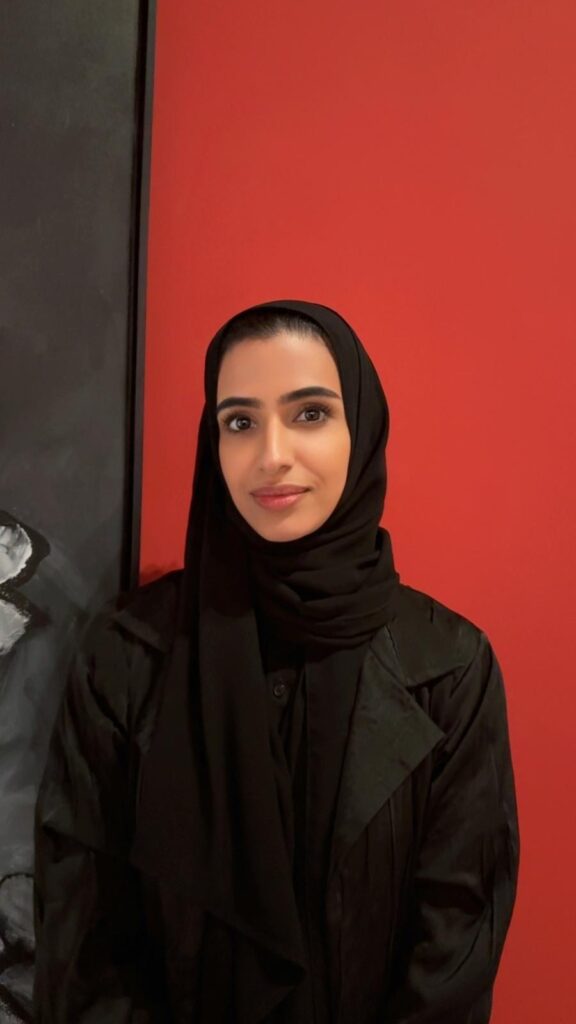
Noof Mohammed, Project Manager, Art Portfolio at QF Communications
SCALE: The museum is based on a sketch by Husain himself. Could you elaborate on how closely the final architectural design follows his vision? Which architect was involved in executing M. F. Husain’s Museum?

The Sketch that became Lawh Wa Qalam: M. F. Husain Museum
Noof: The starting point for the museum emerged from a sketch by Maqbool Fida Husain, depicting a few lines, a blue-tiled façade, the Arabic words Lawh Wa Qalam meaning “the Canvas and the Pen,” and a yellow path leading inside. That sketch carried all the spirit we needed: openness, curiosity, and the union of art and knowledge. We wanted the building to remain faithful to his imagination while functioning as a contemporary museum.
Architect Martand Khosla and his team approached it almost like translating Husain’s visual language into architecture. The mosaic façade recreates the deep blue tones Husain envisioned, inscribed with his chosen words, while the building’s form and sequence follow the rhythm of his storytelling. While one element from Husain’s sketch, a tent-like structure on the right, was not built in its original form, its concept was translated into the rear section of the building.
You move through it the way you might move through one of his paintings — from intimacy to expanse, from stillness to motion. Even the central stair doubles as a gathering place, echoing how Husain saw art as something to be shared. The final design does not replicate his sketch line by line, but it holds onto his intent of creating a living, evolving space where creativity and learning meet.
SCALE: Husain’s work is deeply rooted in both Indian modernism and global contemporary currents. How does the museum convey this dual identity to audiences in Qatar and internationally?
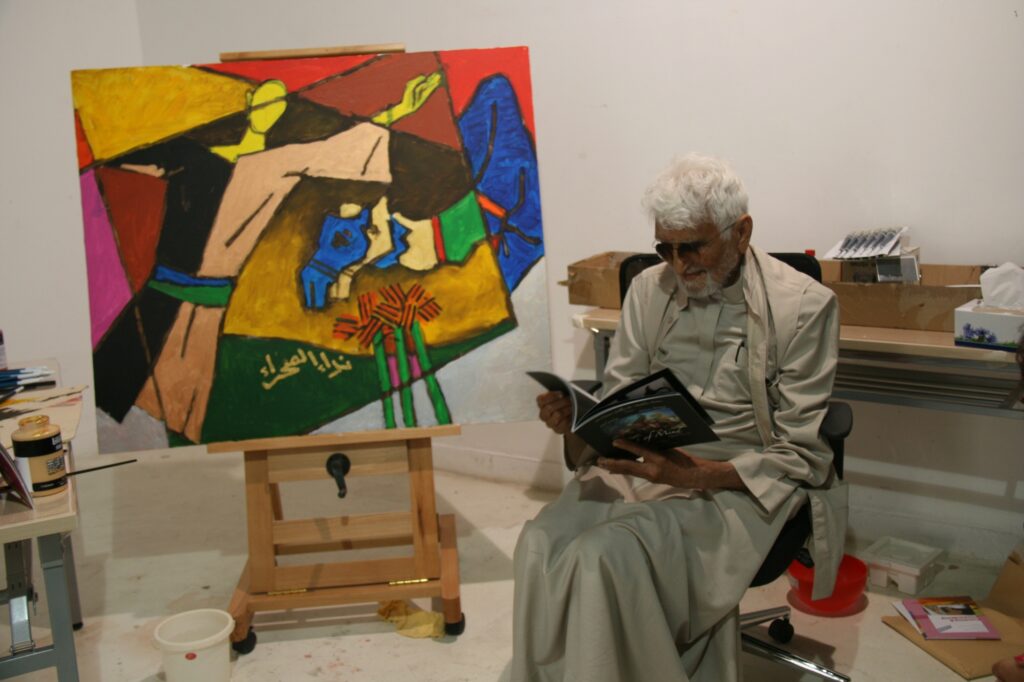
The man and his art.
Noof: Husain’s life and art were always in conversation with many worlds at once. He carried the visual vocabulary of Indian modernism with elements of mythology, folk imagery, the movement of everyday life, and blended it with a contemporary global spirit. The museum reflects that duality in how his story is told. Visitors encounter his early years painting cinema billboards in Mumbai alongside later works inspired by Islamic and Arab civilization. The galleries weave these influences together rather than separating them.
Through film, photography, and archives, we show how his curiosity connected cultures instead of dividing them. His art captured the essence of tradition but also the pulse of modern cities, the movement of people, and the shared language of progress. His travels and encounters shaped this global outlook — from portraits of figures like Mahatma Gandhi, Mother Teresa, and C. V. Raman to his later depiction of Bilal as part of his Arab Civilization series, reflecting his deep engagement with multiple worlds.
In Qatar, that openness deepened further. His work began to draw from Arab civilization and Islamic geometry while still carrying the expressive forms of his Indian modernist roots. The result was a body of work that felt both deeply regional and unmistakably global. The museum mirrors that perspective and invites audiences to see Husain not as an artist from one country or one school, but as a global storyteller who used art to show how identities can expand rather than narrow.
SCALE: Beyond the 35 paintings Husain completed before his passing, part of the commissioned series of 99 inspired by Arab civilization, what other works will visitors encounter, and how were these selected to represent Husain’s multidisciplinary practice?
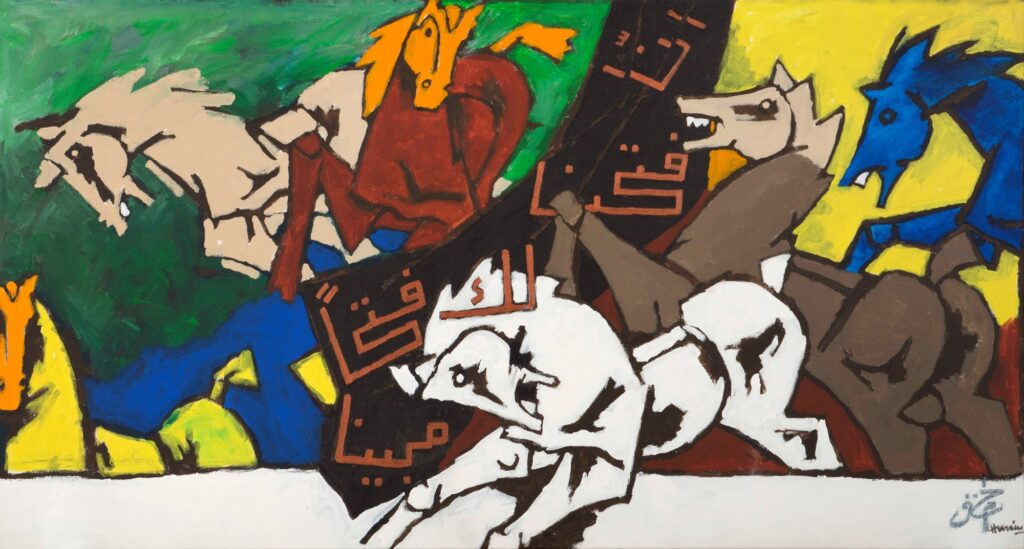
The art of Husain
Noof: The commissioned series on Arab civilization holds special significance within the museum, but it’s just one part of a much wider story. Works from the Arab Civilization series will be on view, alongside pieces that reflect his multidisciplinary spirit — including world religions a monumental triptych exploring the world’s major faiths, as well as sculptures, a self-portrait in tapestry, and excerpts from his films.
Moreover, visitors will encounter over 50 original works and personal objects that span six decades of Husain’s life ranging from his earliest paintings in the 1950s to the last pieces he created in Qatar. The selection includes drawings, photographs, film excerpts, and archival material that show how his ideas evolved across mediums and time.
We wanted the display to feel like a journey through his imagination, not a linear chronology. The galleries are arranged thematically exploring movement, spirituality, civilization, and memory — ideas that kept resurfacing throughout his career.
The curatorial approach is immersive rather than encyclopaedic. Instead of overwhelming visitors with volume, each gallery opens up a different side of Husain: the young artist painting cinema billboards in Mumbai; the modernist reimagining myth and faith; and the thinker exploring Islamic and Arab civilization through form, geometry, and light. It’s an experience that invites you to step inside his world and see how one artist’s creativity could cross borders, disciplines, and generations.
SCALE: The museum includes paintings, films, tapestries, photography, and poetry. How do you balance showcasing Husain’s extensive body of work without overwhelming visitors?
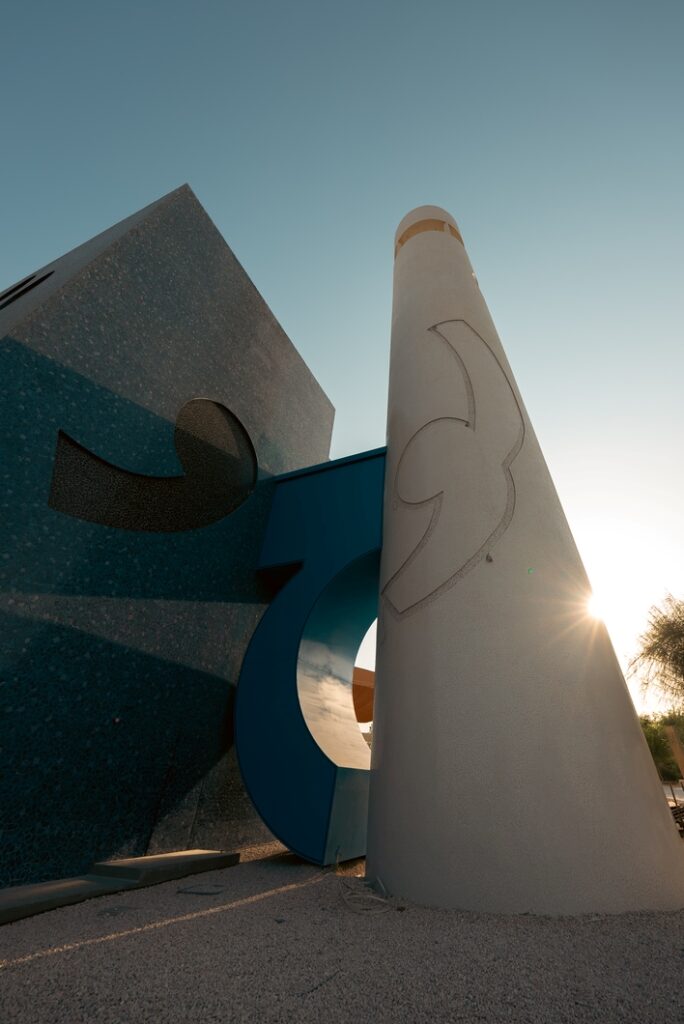
Details Lawh Wa Qalam: M. F. Husain Museum
Noof: One of the most important parts of our process has been to find a rhythm that lets people absorb the depth of his work without losing its intimacy. The museum was designed as an unfolding experience. You begin in personal spaces — his home and studio reimagined — where you can see traces of his process and early influences. From there, the story expands into larger, more immersive galleries that use sound, projection, and light to bring his world to life.
Each space has its own atmosphere. One traces his early years and rise as a storyteller of India’s cultural transformation. Another explores his lifelong engagement with spirituality and how he found visual harmony between Islam, Christianity, Judaism, Hinduism, and other belief systems. The final galleries lead to his later years in Qatar and the creation of Seeroo fi al ardh, his only kinetic installation.
Throughout, there are moments to pause, sit, and reflect. The display changes over time, so not all works are on view at once. This helps keep the experience fresh, focused, and deeply human. Rather than showing everything, the curatorial team has selected his most significant works that best represent his artistic legacy and weave together a strong, coherent narrative. The aim isn’t to show everything, but to create a space that breathes and mirrors Husain’s mind, one that was layered, alive, and constantly moving.
SCALE: How will the museum engage with students and researchers? Will there be dedicated programs, workshops, or research opportunities centered on Husain’s work?
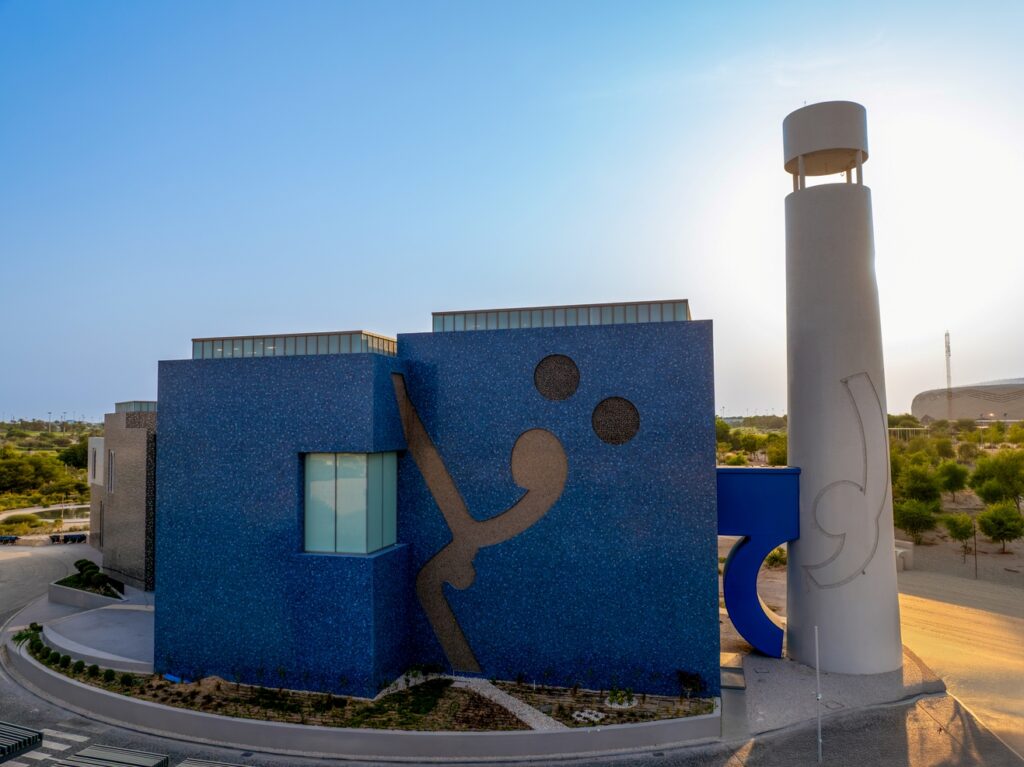
The Facade of the new Museum
Noof: Education has always been central to what we do at Qatar Foundation, and this museum continues that belief in a very direct way. Lawh Wa Qalam: M. F Husain Museum is designed as an active space, not one where you only observe, but where you take part. We want students, artists, and researchers to use it as a place to explore ideas, to question, and to experiment through the lens of Husain’s work.
The museum will have a dedicated family exhibit to offer children an interactive space to learn and play. At the same time, outreach programs are being developed with teachers to introduce Husain’s story in classrooms before their visits. The museum will also host conferences and talks exploring his life, work, and legacy, creating new platforms for learning and exchange.
Being located in Education City makes this especially meaningful. Surrounded by schools, universities, and research centers, the museum becomes a living classroom and a place where learning happens through seeing, making, and curiosity, just as it did for Husain throughout his life.
SCALE: Husain often drew inspiration from storytelling and cinema. How will the museum use multimedia and immersive installations to bring this narrative quality to life for younger, digitally native audiences?

Parthiv Shah, MF Husain during his exhibition Let History Cut Across Me Without Me NGMA-New-Delhi-1993
Noof: Husain had a natural instinct for storytelling. He painted like a filmmaker – fast, expressive, always in motion. We wanted that sense of energy to guide how people experience the museum. The galleries unfold through a sequence of spaces, beginning with the artist’s home and studio before expanding into larger galleries where sound, projection, and light bring his world to life. His own films are part of the experience, shown alongside the paintings that share their rhythm and emotion.
For younger audiences, we’ve used technology carefully, not as spectacle but as a bridge to connect them to Husain’s world. Archival footage, subtle projections, and layered soundscapes create moments that feel immersive without ever overwhelming the art itself. Visitors can trace how his stories moved from canvas to camera and back again. It’s designed to feel alive, as if you’re walking through his imagination, living an experience that reminds us that storytelling, whether in paint or film, is really about how we see and feel the world around us.
The experience also includes a 360-degree immersive room where visitors can step into Husain’s world, and a theatrical showcase of Seeroo fi al ardh that brings his kinetic vision to life through light, movement, and sound.
SCALE: With over 100 public artworks already present in Education City, how does this museum contribute to Qatar Foundation’s cultural ecosystem?
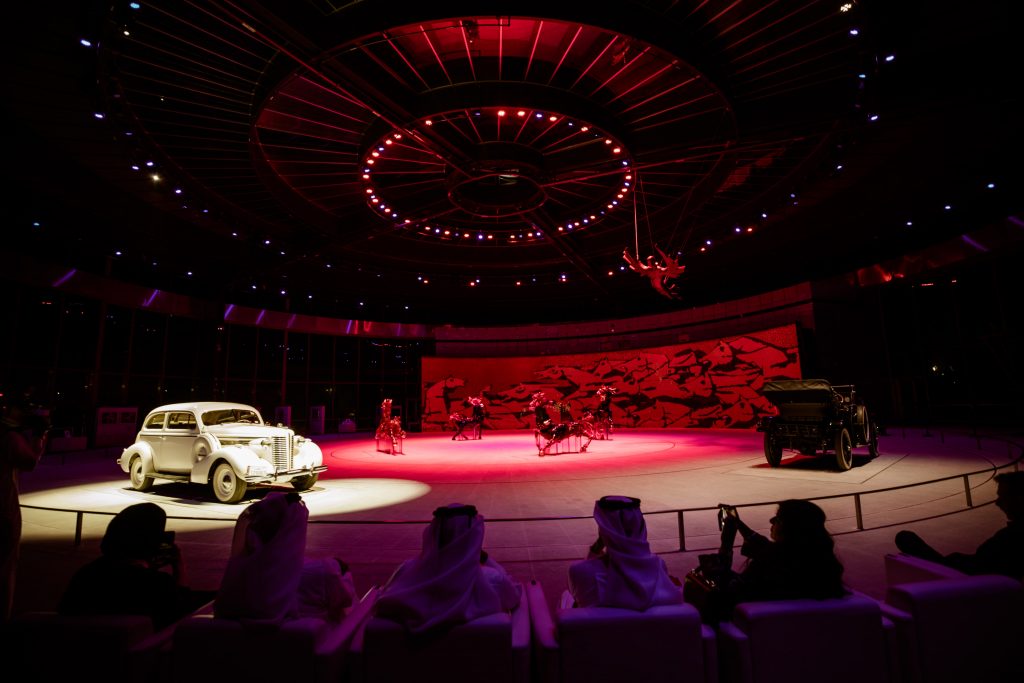
During the opening night of the installation Seeroo fi al ardh, with all the vintage cars on display along with the work of art by Husain.
Noof: Education City has always been a place where learning takes many forms, be it through architecture, design, or art that people encounter as part of their daily lives. Lawh Wa Qalam: M. F. Husain Museum adds another layer to that landscape as the first dedicated museum within Education City that brings one artist’s journey into the heart of an academic environment. Situated near Seeroo fi al ardh, Husain’s final and most ambitious work, the museum serves as a cornerstone for storytelling and reflection — adding depth, context, and narrative to the public art that animates the campus.
While the public artworks across Education City invite discovery in open spaces, the museum offers something more intimate. It’s a space to pause, to study, to connect. It also extends our work with schools, universities, and research centers, giving students and faculty a place to experience art in context, not apart from education, but as part of it. In many ways, it embodies what Qatar Foundation stands for: the belief that creativity, knowledge, and learning are all part of the same conversation.
SCALE: How do you see Lawh Wa Qalam: M. F. Husain Museum contributing to Qatar’s broader cultural positioning globally, alongside institutions like the Museum of Islamic Art, Mathaf, and the National Museum of Qatar?
Noof: Every institution in Qatar tells a different part of the story. The Museum of Islamic Art celebrates the rich heritage or our faith, Mathaf: Arab Museum of Modern Art speaks to the evolution of modern and contemporary Arab art, and the National Museum of Qatar traces the country’s narrative through time. Lawh Wa Qalam: M. F. Husain Museum adds a new voice — one that connects these strands through the life of a single artist whose work bridges cultures and generations.
By dedicating an entire museum to M. F. Husain, Qatar is celebrating the value of artistic exchange. His story reflects what the country itself represents today: a meeting point for ideas, creativity, and dialogue.
As Qatar continues to grow as a multicultural hub and global destination, the museum strengthens this ecosystem by celebrating cross-cultural dialogue and artistic exchange, welcoming both local communities and international visitors. The museum reinforces Qatar’s position not just as a supporter of art, but as a place where knowledge and culture are continuously reinterpreted and shared. It deepens the cultural landscape, reminding us that art is not just about preservation, but about perspective and about creating new ways to see the world.
SCALE: Will the museum collaborate with Indian and international cultural institutions to expand its reach and bring diverse perspectives on Husain’s art?
Noof: That’s something we’re very excited about. Collaboration feels like a natural extension of Husain’s own philosophy as he was always in conversation with the world. We’re looking forward to exploring ways to connect with international museums that can open new perspectives on his practice.
These partnerships will take many forms, from joint exhibitions, conferences, residencies, and travelling shows to collaborative publications and exchange programs, each designed to deepen engagement and connect Husain’s story with audiences around the world. The museum was built to be open and collaborative, and partnerships like these will help it stay alive, constantly renewed by different voices and interpretations.
SCALE: If Husain were alive to walk through Lawh Wa Qalam today, what do you think his reaction would be?

From an earlier file pic during the launch of Seeroo fi al ardh
Noof: I think he would recognize the space immediately — not only for its design, but for its spirit as well. The museum carries his handwriting in the blue tiles, in the calligraphy on the façade, and in the way the light moves through each room. Husain always spoke of art as something living, something that should grow beyond the artist. Walking through this museum, he would probably see that spirit continuing, and recognize how his vision has been built upon to speak to new generations. For someone always ahead of his time, seeing young visitors engage so interactively with his work would have delighted him.
This museum would stand before him as the realization of his vision made real in stone and light, a living canvas brought to life from his sketch. I think he would likely feel a tranquil belonging to the space and a quiet joy in knowing that what began in his hands has grown into a space that continues to move, to breathe, and to belong to everyone who steps inside.
Pic Courtesy QF Communications and QM

